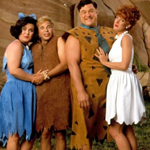

May 27, 1994
The Flintstones are an example of a pop culture phenomenon that’s long past its relevance, but it’s so simple and recognizable that it lingers like a ghost in the public memory. Or like a fossil! As the first prime time cartoon, it originally aired between 1960 and 1966, but more than half a century later – whether because of the spin-offs and TV movies, the vitamins and cereals, or just cultural omnipresence – almost any American could identify the show on sight.
That doesn’t mean they’ve given it much thought, though, because there’s not much to chew on here. I know I watched it for some period of my life, but couldn’t point to a favorite episode, or even a specific one. There are different stories, technically, but the joke doesn’t really go beyond “what if there was a Honeymooners type family sitcom, but with cave men?,” and with the gimmick that modern lifestyles and technology (cars, drive-in theaters, kitchen appliances) exist, crudely constructed out of rocks, bones, wood, animal skins, and talking, subservient prehistoric animals. The plots reflect the same middle class concerns as a normal show would – trying to keep your job to pay for the house, trying to make your wife not mad that you spend too much time out with your buddies – but mostly it’s that one anachronistic joke of “the modern stone age family.” It’s humor with one wink and a whole lot of taken-for-granted cartoonist ingenuity.
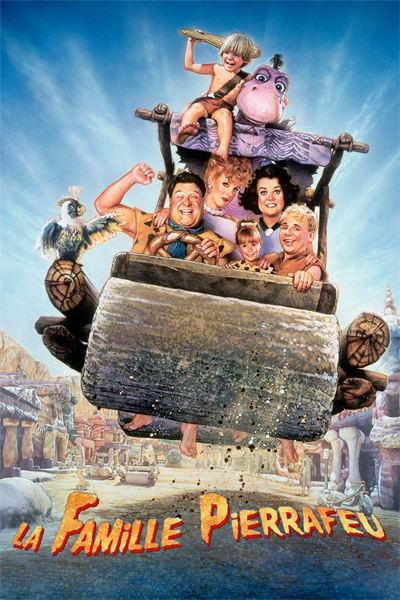
And the movie THE FLINTSTONES, for better or worse, doesn’t have much more ambition than to recreate that in a feature length live action movie. Unlike most of the movies in this Summer Flings series, it was a giant box office hit, with a record breaking opening weekend and ultimately earning $341 million worldwide on a $46 million dollar budget. But it got mostly negative reviews and had a reputation as a bad movie – you can tell that because those hacks at the Razzies gave it four nominations and two wins, for worst screenplay and worst supporting actress Rosie O’Donnell. She does a fine Betty Rubble, but was widely and openly criticized for not being skinny like the cartoon drawing. Spielberg hadn’t thought to ask if people were mainly going to this to jerk off, and if so what their preferences were.
I don’t think this is a movie that many people remember fondly, if they remember it at all.
At the time there was definitely resentment toward it as an empty-calorie corporate product. There was still time to push back against Hollywood trying to turn every damn registered trademark into a giant summer movie, and the amount of money and effort Universal put into producing and hyping such a silly idea – including having a teaser trailer attached to JURASSIC PARK a year in advance – rubbed people the wrong way. Director Brian Levant brought in eight sitcom writers to punch up the script, then had four more round table sessions with additional writers until a total of 32 had worked on it, so that number was often cited as an example of absurd Hollywood excess. “It took 32 writers to write that? Ha ha ha, I got ’em.”
Watching it now, though, I mean… maybe it’s just me, but… I think it’s got a little charm to it? It’s definitely a lightweight, surface level movie. Unlike POPEYE or DICK TRACY, they don’t add much emotional depth to the cartoon world. But I remember when I saw this at a dollar theater in the year of 1 A.J.P. (After Jurassic Park) it was exciting to see the shots where Dino ran by, because it was new to see a digital model based on a cartoon design but with realistic textures. According to the director’s commentary track there were 56 c.g. shots in the movie, which was alot then.
But in 24 A.J.P. that’s barely any, and my reaction is kind of the opposite. It’s ‘holy shit, look at that gigantic set! And that gigantic set! Look at all these props!’ They took those cartoon designs, based in the stylish limited animation of the era, the creative interpretations of 1960s furniture, architecture and fashion, and then they figured out how to capture that style, but with the textures of real materials. And they built all those things – houses, businesses, cars, machines – and populated them with people who kinda looked like the cartoons, but real, and animatronic puppet dinosaurs created by Jim Henson’s Creature Shop acting as garbage disposals, cranes, record players, dictaphones…
I mean, this must be one of the last hand-made productions of this size and detail. 1994’s shameful excess is 2017’s good ol’ days.
Look at this. They built Bedrock! The cars, the trees, the playgrounds, the “Chevrok,” presumably the official fossil fuel of THE FLINTSTONES.
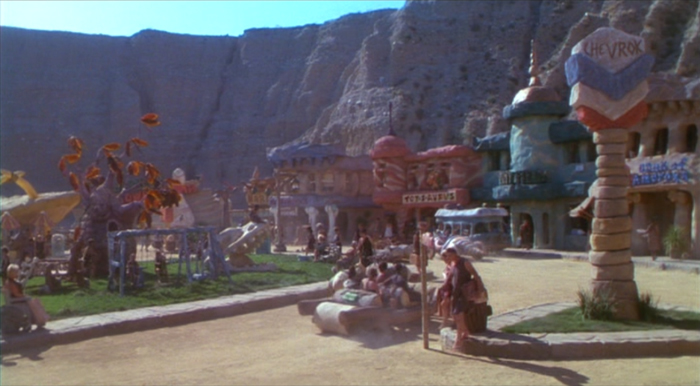
Look at this telephone. This stone tablet newspaper.
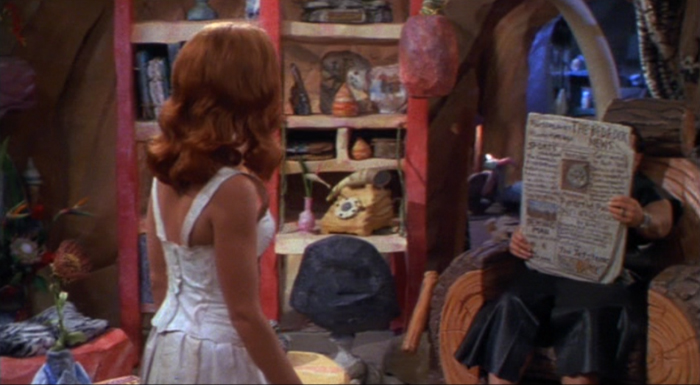
Look at these guys. They’re puppets! Dino is amazingly expressive with his face and paws.
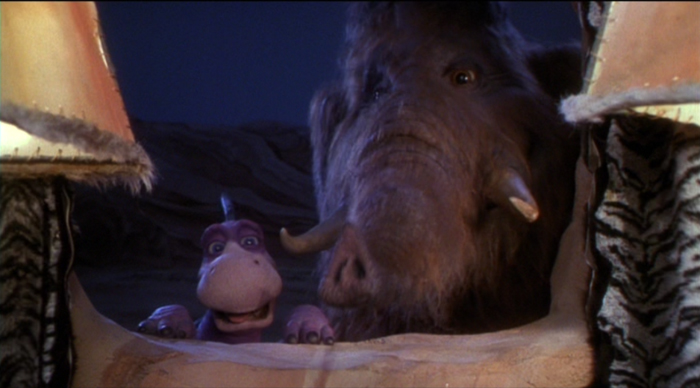
And then they face a challenge like creating a fancy lobby for the Slate and Co. corporate offices. So they figure out the Flintstones version of marble walls, installation art, a glass elevator.
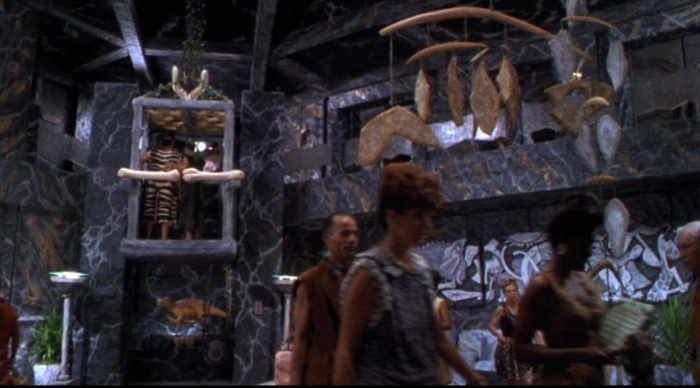
And obviously they gotta get some visual gags in there, like the record collection on display here. Dumb joke, but exactly the same dumb as the cartoon.
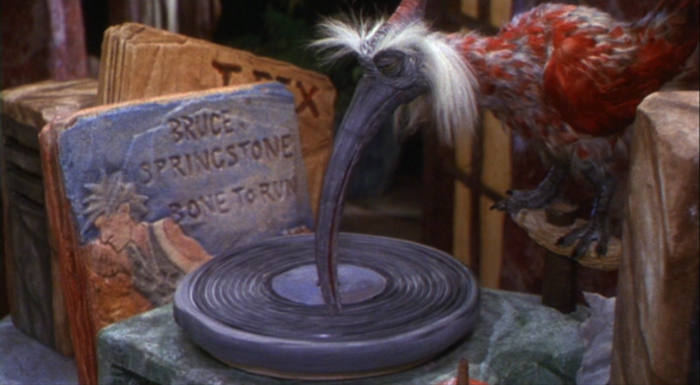
To the extent that there is any emotional core to this movie, it’s about the friendship between Fred (John Goodman, DEATH SENTENCE) and Barney (Rick Moranis, STREETS OF FIRE). I remember Fred being an asshole in the cartoon, but here that’s kind of a front. At the beginning of the movie he’s in trouble with Wilma (Elizabeth Perkins, THE RING TWO) for spending too much of their savings, but he actually secretly loaned it to Barney to help him adopt Bam Bam. Barney returns the favor by switching their aptitude tests, which gets Fred promoted and Barney fired. So there are some tensions there that they gotta deal with, and their wives get stuck in the middle and what not.
This is of course exactly as sitcom-y as the show, but it has to hold our attention longer. Luckily Goodman and Moranis each have an inherent humanity and a chemistry together. And seeing Goodman as a leading man is a rare treat.
Of course there’s a bad guy and a secret plot and at the end he takes the kids hostage and there’s a dumb battle in the rock quarry. Slate and Co. junior exec douche Cliff Vandercave (Kyle MacLachlan, the guy from that TV show everybody is so god damned obsessed with and talking about all the time, Desperate Housewives) promotes Fred to use as his fall guy in an embezzling scheme. He’s aided by a femme fatale-ish secretary played by the not-very-famous-yet Halle Berry (THE LAST BOY SCOUT). I still think it’s funny that her character is named Sharon Stone, and research confirms that it was meant for the real Sharon Stone but it didn’t fit into her schedule (maybe she would’ve been filming THE SPECIALIST?).
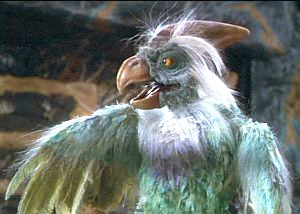 I like that Fred’s “dictabird” – a prehistoric bird that sits on his desk and takes dictation – is actually a major character. He’s a puppet with the voice of Harvey Korman and is more important to the plot than Elizabeth Taylor as Fred’s mother-in-law.
I like that Fred’s “dictabird” – a prehistoric bird that sits on his desk and takes dictation – is actually a major character. He’s a puppet with the voice of Harvey Korman and is more important to the plot than Elizabeth Taylor as Fred’s mother-in-law.
On the cartoon sometimes they would have characters that were based on contemporary celebrities, but with geological puns in their names. For example Cary Grant was Gary Granite, and the recent Flinstones/WWE crossover movie STONE AGE SMACKDOWN has Vince McMahon voicing the part of Vince McMagma. Here we have the B-52s appearing as the BC-52s. And like so many Hanna-Barbera cartoons it just turns into a music video and Fred is surprisingly into dancing. He seemed like a non-dancer to me but my assumptions were wrong.
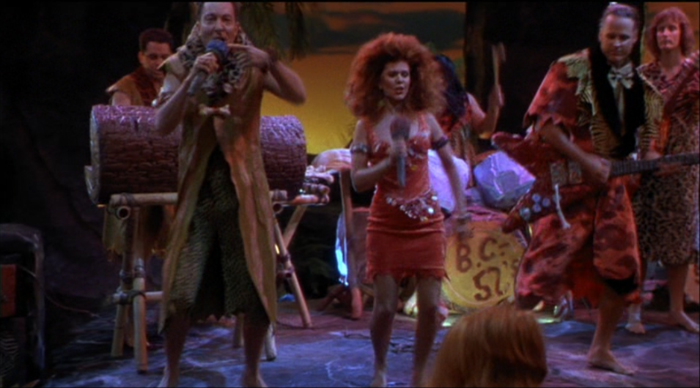
One weird embellishment to the cartoon is the detail that there are people in Bedrock who are neanderthals, with larger foreheads than the Flintstones and Rubbles. Some of them work at the factory with Fred, and they seem to be an underclass. Fred proudly says that his lodge no longer allows neanderthals as members. That’s fucked up!
Levant is a huge Flintstones fan and collector, and I’m sure there aren’t too many of those who also know how to direct a movie, so I get why they chose him. But is it fair to say he’s a pretty for-hire choice of director? His filmography up until that point consisted of episodes of Married With Children, The New Leave It To Beaver and Charles in Charge, and the films PROBLEM CHILD 2 and BEETHOVEN. His subsequent movies include JINGLE ALL THE WAY, SNOW DOGS and ARE WE THERE YET?, as well as the prequel to this one and some SCOOBY-DOO! tv movies. He also wrote the TV movie STILL THE BEAVER and the 1997 LEAVE IT TO BEAVER movie. I haven’t seen almost any of these, but it seems like a good bet that this is his best movie. He pulled off the job with more skill than expected, though also the exact amount of artistic vision expected.
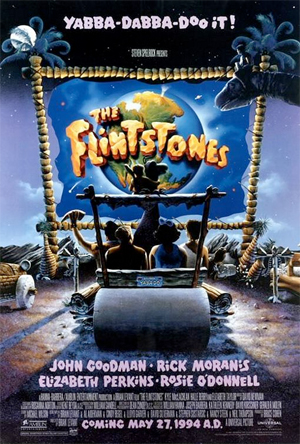 Steven E. de Souza (DIE HARD, KNOCK OFF, STREET FIGHTER: THE MOVIE) wrote the first draft of the script for Joel Silver in 1985. It went through four other drafts, including one by Mitch Markowitz (GOOD MORNING VIETNAM) that he said was based on The Grapes of Wrath. “Fred and Barney leave their town during a terrible depression and go across the country… They exhibit moments of heroism and poignancy.” Richard Donner was set to direct, but reportedly thought it was “too sentimental.”
Steven E. de Souza (DIE HARD, KNOCK OFF, STREET FIGHTER: THE MOVIE) wrote the first draft of the script for Joel Silver in 1985. It went through four other drafts, including one by Mitch Markowitz (GOOD MORNING VIETNAM) that he said was based on The Grapes of Wrath. “Fred and Barney leave their town during a terrible depression and go across the country… They exhibit moments of heroism and poignancy.” Richard Donner was set to direct, but reportedly thought it was “too sentimental.”
Speaking of sentimental, Spielberg bought the rights in 1988 because he worked with Goodman on ALWAYS and thought he should play Fred Flintstone. You know, always looking out for his friends.
The idea of the infamous 32 writers was to do it like a TV writer’s room. I imagine most of them were trying to add jokes, not plot twists, that’s why it’s coherent despite so many cooks. When all those names were submitted to the Writer’s Guild for arbitration it caused controversy. Writers were worried it would set a dangerous precedent, so some of them pulled out of arbitration. The credit went to De Souza and the team of Tom S. Parker & Jim Jennewein (uncredited writers on SUPER MARIO BROS.!), who had only worked on the movie pre-Levant.
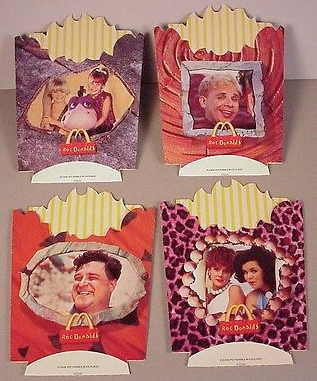 One image that is emblematic of THE FLINTSTONES is the RocDonalds restaurant. It’s a perfectly organic joke that Bedrock would have their version of the omnipresent fast food chain, and instead of a sign telling how many billions sold it would be in the dozens.
One image that is emblematic of THE FLINTSTONES is the RocDonalds restaurant. It’s a perfectly organic joke that Bedrock would have their version of the omnipresent fast food chain, and instead of a sign telling how many billions sold it would be in the dozens.
But also the movie had a tie-in with the real restaurant and they filmed ads on this set. People don’t like that type of product placement. Entertainment Weekly even quoted Goodman as saying, “My Fred Flintstone doll is okay, but when I saw my face on a package of french fries, well that’s enough already.”
On the other hand, I mean, look at it in the movie:
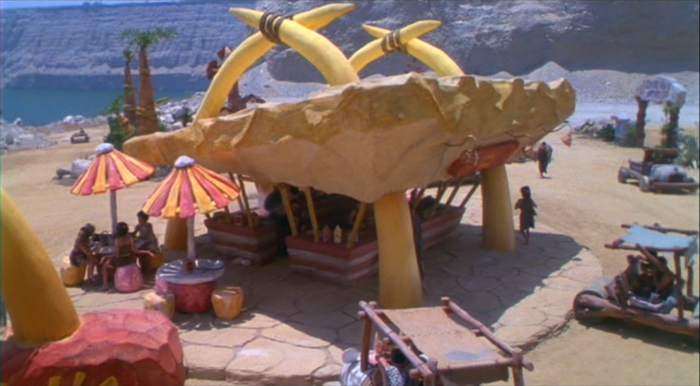
Just as a piece of design it’s pretty fuckin cool.
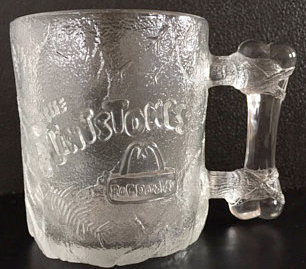 But yeah, they merchandised the shit out of this one. Products included (but were not limited to): action figures, talking dolls, bendies, dinosaur keychains, miniature vehicle Happy Meal toys, drinking glasses made to look like they were chiseled out of rock and bone (similar to later BATMAN FOREVER mugs), trading cards, watches, a Super Nintendo game, a pinball machine, and a comic book adaptation where you could see John Goodman or traditional cartoon Fred depending on which color of glasses you look through.
But yeah, they merchandised the shit out of this one. Products included (but were not limited to): action figures, talking dolls, bendies, dinosaur keychains, miniature vehicle Happy Meal toys, drinking glasses made to look like they were chiseled out of rock and bone (similar to later BATMAN FOREVER mugs), trading cards, watches, a Super Nintendo game, a pinball machine, and a comic book adaptation where you could see John Goodman or traditional cartoon Fred depending on which color of glasses you look through.
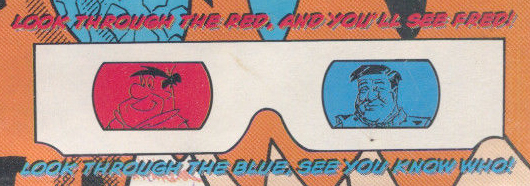
And of course there was a soundtrack, kind of. It had some of David Newman’s score and the two songs by the BC-52s. Like SUPER MARIO BROS. it has “Walk the Dinosaur” (original version though) and like COOL WORLD it has a song by My Life With the Thrill Kill Kult (just on the album, I think). You also got Weird Al and the end credits song where the band Green Jelly redoes “Anarchy in the UK” for the world of the Flintstones. Like the Sex Pistols originally intended.
These Mattel action figures crack me up because here they have a pretty realistic John Goodman face attached to a body with the proportions of the cartoon character. It’s bizarre but at least there’s a logic to it, unlike the DICK TRACY ones.
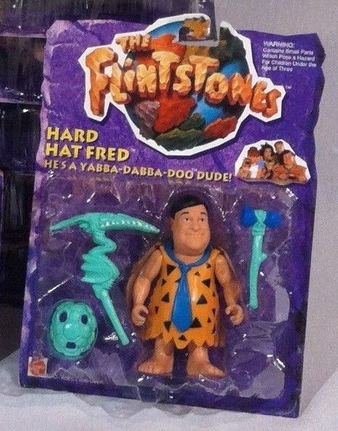
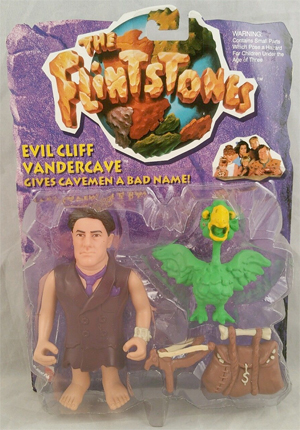
Also it’s pretty cool that there’s a Kyle MacLachlan action figure, although it wasn’t his first or last. (He had one for DUNE and now for Twin Peaks.)
A March 1994 L.A. Times article said THE FLINTSTONES had over 100 licensees, but speculated that THE LION KING might sell more crap with less than half as many.
“My gut feeling is, John Goodman’s picture should not be on the merchandise,” said Harry Clark Noyes, president of the marketing research firm Psychological Motivation.
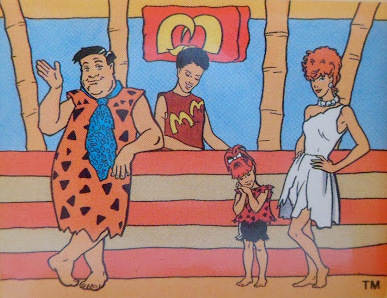 A month later, Ad Age declared that “the film’s promotional tie-ins aren’t yabba-dabba-dooing it for most kids.” A sampling of children interviewed all liked the movie and were aware of its McDonalds tie-ins, but most weren’t interested in owning any merchandise. The next summer Entertainment Weekly reported that “Though Disney’s $313 million-grossing THE LION KING exceeded $1 billion in total merchandise sales last year, Universal’s THE FLINTSTONES, which grossed a robust $130 million, saw rocky toy sales.”
A month later, Ad Age declared that “the film’s promotional tie-ins aren’t yabba-dabba-dooing it for most kids.” A sampling of children interviewed all liked the movie and were aware of its McDonalds tie-ins, but most weren’t interested in owning any merchandise. The next summer Entertainment Weekly reported that “Though Disney’s $313 million-grossing THE LION KING exceeded $1 billion in total merchandise sales last year, Universal’s THE FLINTSTONES, which grossed a robust $130 million, saw rocky toy sales.”
You get it though? Rocky.
I think this all worked out for the best. The kids didn’t go for all the commercialism, but the craftsmen got to build Bedrock for us to look at. I don’t know, man. I’m not saying it’s not THE FLINTSTONES. That’s all it is. But I’m not mad they made it.
–this has been a review by OUTROCK VERN
additional source:
Bringing ‘The Flintstones’ to the big screen – Entertainment Weekly


























June 14th, 2017 at 10:29 am
When I saw The Nice Guys, I thought two things:
-What a great movie.
-Crowe and Gosling would make a terrific Fred & Barney.
Think about it.